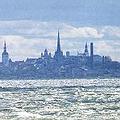 波羅的海周邊9個國家與歐盟22日在為期兩天的赫爾辛基委員會(波羅的海海洋環境保護委員會,HELCOM)會議上共同宣佈,先前被指定為波羅的海重度污染源的11處地點,經過一番整治後確認可從「污染熱點」名單上移除,其中包括了愛沙尼亞首都塔林。
波羅的海周邊9個國家與歐盟22日在為期兩天的赫爾辛基委員會(波羅的海海洋環境保護委員會,HELCOM)會議上共同宣佈,先前被指定為波羅的海重度污染源的11處地點,經過一番整治後確認可從「污染熱點」名單上移除,其中包括了愛沙尼亞首都塔林。
立陶宛籍赫爾辛基委員會主席道布拉斯(Arturas Daubaras)表示:「整治污染熱點的行動,是我們邁向更乾淨的海洋環境的一大步。」他表示,正在進行中的整治行動,未來將納入波羅的海行動計畫的策略之中。
遭除名的污染熱點中,包還了位於俄羅斯聖彼得堡的7座市立廢水處理廠。赫爾辛基委員會秘書佛西斯(Kaj Forsius)表示:「我們看到了許多進展,例如都市廢水處理設施和工業廠房等主要污染源減廢工作。以往名列為污染熱點,如今其廢水處理效率已達到了赫爾辛基委員會的建議標準。」
赫爾辛基委員會是在1992年的制定「波羅的海聯合環境行動計畫」時,首次擬定了波羅的海周邊的污染熱點。最惡名昭彰的熱點包括如都市設施、工業廠房等主要污染源,而該計畫也涵蓋了來自農業地區、鄉間聚落,以及如海岸潟湖、溼地等需要特別採取環保措施的區域。計畫中預期最慢在2012年以前,擬定一系列污染熱點整治行動的細則。
擬定這些環境熱點的人員包括一群科學家、工程師、環境管理者、銀行家以及國家代表所組成的國際團體所指定,他們的考量包括實際經濟面以及這些熱點對環境以及人類健康衝擊的嚴重性。
計畫發展的下一步驟將是確認並詳列所需採取的行動,以在下列4個主要環境優先議題的個別時限內達成大家共同的環境目標:遏止優養化、防止與危險物質有關的污染、促進航海安全和意外應變能力、以及終止棲地的破壞和生物多樣性的惡化。
Eleven designated "hot spots" have been removed from the list of the Baltic Sea's worst sources of pollution following a review of cleanup efforts, officials from the nine Baltic Sea coastal countries and the European Union announced here today at the conclusion of a two day meeting. Among the hot spots removed from the list is the Estonian capital city of Tallinn.
"The remedial actions at the hot spots should be seen as one of the major steps towards achieving a cleaner marine environment," said Chairman of the Helsinki Commission Arturas Daubaras of Lithuania. He said ongoing remedial activities will be part of the strategic Baltic Sea Action Plan.
Seven municipal wastewater treatment plants in St. Petersburg, Russia were removed from the list.
"We are witnessing very good progress in the reduction of pollution from point sources such as municipal wastewater treatment facilities, as well as industrial plants," said Kaj Forsius, professional secretary of HELCOM. "Wastewater treatment efficiency at the former hot spots now meets the requirements of the relevant HELCOM Recommendations."
The hot spots list of the most significant point sources of pollution around the Baltic Sea was first drawn up under the HELCOM Baltic Sea Joint Comprehensive Environmental Action Programme (JCP) in 1992.
The most notorious hot spots are point sources such as municipal facilities and industrial plants, but the program also covers pollution from agricultural areas and rural settlements, and sensitive areas such as coastal lagoons and wetlands where special environmental measures are needed.
The program, which is expected to be completed by 2012 at the latest, specifies a series of actions to be undertaken at pollution hot spots.
The environmental hot spots were designated in 1992 by an international group of scientists, engineers, environmental managers, bankers and national representatives, according to practical economic considerations as well as the seriousness of their impact on the environment and human health.
The next step in the development of the plan will be to identify and detail the kind of actions needed to achieve the agreed environmental objectives within a given timeframe for each of the four main environmental priority issues - curbing eutrophication, preventing pollution involving hazardous substances, improving safety of navigation and accident response capacity, and halting habitat destruction and the decline in biodiversity.


